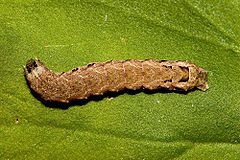- Lesser Yellow Underwing
-
Lesser Yellow Underwing 
Scientific classification Kingdom: Animalia Phylum: Arthropoda Class: Insecta Order: Lepidoptera Family: Noctuidae Genus: Noctua Species: N. comes Binomial name Noctua comes
Hübner, 1813The Lesser Yellow Underwing (Noctua comes) is a moth of the family Noctuidae. It is found throughout Europe. It was introduced into British Columbia in about 1982 and has spread southward in the Pacific Northwest. It has recently been reported from Ontario (Crolla 2008). Full synonymy given in Lafontaine. It is a common species but not as abundant as its larger relative Large Yellow Underwing.
This species generally has the appearance of a "scaled-down" (wingspan 38-48 mm) version of the Large Yellow Underwing. The forewings are equally variable, from light brown to almost black and it also has orange-yellow hindwings with a black sub-terminal band. The hindwings also have a black discal spot, usually absent from the larger species. It flies at night from July to September [1] and is attracted to light and flowers such as heather, marram grass and ragwort.
The larva is also very similar to that of Large Yellow Underwing, green or brown with black dashes along the back. Its feeding habits, however, are very different: this is not a "cutworm" but feeds on the foliage of a range of plants, trees and shrubs as well as herbaceous plants (see list below). This species overwinters as a larva.
- ^ The flight season refers to the British Isles. This may vary in other parts of the range.
Recorded food plants
- Betula - Birch
- Calluna - Heather
- Cirsium - Thistle
- Crataegus - Hawthorn
- Digitalis - Foxglove
- Fragaria - Strawberry
- Plantago - Plantain
- Prunus - Blackthorn
- Rumex
- Salix - Willow
References
- Chinery, Michael Collins Guide to the Insects of Britain and Western Europe 1986 (Reprinted 1991)
- Skinner, Bernard Colour Identification Guide to Moths of the British Isles 1984

This Noctuinae-related article is a stub. You can help Wikipedia by expanding it.



